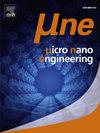Micro-digital light processing of conventional and hollow Gyroid mesoscale hydrogel scaffolds for neural cell cultures
IF 3.1
Q2 ENGINEERING, ELECTRICAL & ELECTRONIC
引用次数: 0
Abstract
Here, we report a high-resolution micro-digital light processing (μDLP) 3D printing protocol for fabricating soft hydrogel scaffolds featuring mesoscale millimetre-sized gyroid-based architectures tailored for 3D neural cell culture. The developed bioink formulation combines poly(ethylene glycol) diacrylate (PEGDA), as the structural backbone, and gelatin methacryloyl (GelMA), to enhance biocompatibility and promote cell adhesion via arginylglycylaspartic acid (RGD) motifs. By combining lithium phenyl (2,4,6-trimethylbenzoyl) phosphinate (LAP) as photoinitiator, along with tartrazine as photoabsorber, we achieved feature sizes down to 12.4 μm with high printing fidelity, reproducibility, and mechanical stability. The mechanical properties of the resulting hydrogel structures showed a Young's modulus (YM) in the 770 kPa – 2.25 MPa range, depending on the presence of GelMA, thus very relevant for neural cells (brain YM in the kPa range), along with remarkable biocompatibility (≈80 % cell viability) and good cell adhesion (≈55 % cell coverage). Two scaffold geometries based on triply periodic minimal surface gyroids were developed: a fully porous structure for culturing dissociated neuroepithelial stem cells and a hollow variant designed to host pre-formed neural organoids. Both scaffold types enabled strong cell adhesion and organoid sprouting, thereby demonstrating their suitability for advanced 3D culture systems. The results highlight the potential of μDLP-fabricated hydrogel meso-scale architectures as a platform for neuromechanobiology studies and tissue-mimetic engineering.

神经细胞培养用常规和空心陀螺中尺度水凝胶支架的微数字光处理
在这里,我们报告了一种高分辨率微数字光处理(μDLP) 3D打印方案,用于制造具有中尺度毫米尺寸的基于陀螺仪的结构的软水凝胶支架,用于3D神经细胞培养。所开发的生物墨水配方将聚乙二醇二丙烯酸酯(PEGDA)作为结构骨架和明胶甲基丙烯酰(GelMA)结合在一起,通过精氨酸基甘氨酸(RGD)基元增强生物相容性并促进细胞粘附。通过结合苯基(2,4,6-三甲基苯甲酰)膦酸锂(LAP)作为光引发剂,酒黄作为光吸收剂,我们实现了小至12.4 μm的特征尺寸,具有高打印保真度、再现性和机械稳定性。所得到的水凝胶结构的力学性能显示,杨氏模量(YM)在770 kPa - 2.25 MPa范围内,取决于GelMA的存在,因此与神经细胞非常相关(脑YM在kPa范围内),同时具有显著的生物相容性(≈80%的细胞活力)和良好的细胞粘附性(≈55%的细胞覆盖率)。研究人员开发了两种基于三周期最小表面陀螺仪的支架几何结构:一种是用于培养分离的神经上皮干细胞的全多孔结构,另一种是用于容纳预先形成的神经类器官的空心结构。这两种支架类型都具有很强的细胞粘附性和类器官发芽能力,从而证明了它们适用于先进的3D培养系统。这些结果突出了μ dlp制备的水凝胶中尺度结构作为神经力学生物学研究和组织模拟工程平台的潜力。
本文章由计算机程序翻译,如有差异,请以英文原文为准。
求助全文
约1分钟内获得全文
求助全文
来源期刊

Micro and Nano Engineering
Engineering-Electrical and Electronic Engineering
CiteScore
3.30
自引率
0.00%
发文量
67
审稿时长
80 days
 求助内容:
求助内容: 应助结果提醒方式:
应助结果提醒方式:


